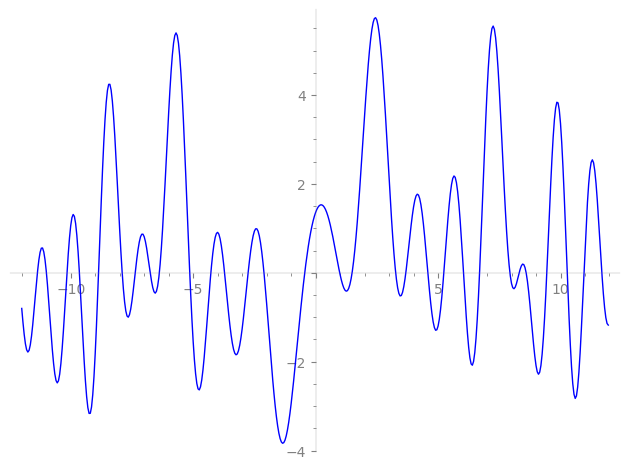| L(s) = 1 | + (−1.94 + 3.37i)5-s + (2.18 + 3.78i)11-s + (0.792 + 1.37i)13-s + (2.66 − 4.61i)17-s + (−2.32 − 4.02i)19-s + (0.183 − 0.318i)23-s + (−5.07 − 8.79i)25-s + (5.08 − 8.81i)29-s + 2.29·31-s + (−5.44 − 9.42i)37-s + (−0.690 − 1.19i)41-s + (3.81 − 6.61i)43-s − 7.60·47-s + (−0.462 + 0.801i)53-s − 17.0·55-s + ⋯ |
| L(s) = 1 | + (−0.870 + 1.50i)5-s + (0.659 + 1.14i)11-s + (0.219 + 0.380i)13-s + (0.646 − 1.12i)17-s + (−0.532 − 0.922i)19-s + (0.0383 − 0.0664i)23-s + (−1.01 − 1.75i)25-s + (0.944 − 1.63i)29-s + 0.412·31-s + (−0.894 − 1.54i)37-s + (−0.107 − 0.186i)41-s + (0.582 − 1.00i)43-s − 1.10·47-s + (−0.0635 + 0.110i)53-s − 2.29·55-s + ⋯ |
\[\begin{aligned}\Lambda(s)=\mathstrut & 5292 ^{s/2} \, \Gamma_{\C}(s) \, L(s)\cr =\mathstrut & (0.941 + 0.335i)\, \overline{\Lambda}(2-s) \end{aligned}\]
\[\begin{aligned}\Lambda(s)=\mathstrut & 5292 ^{s/2} \, \Gamma_{\C}(s+1/2) \, L(s)\cr =\mathstrut & (0.941 + 0.335i)\, \overline{\Lambda}(1-s) \end{aligned}\]
Particular Values
| \(L(1)\) |
\(\approx\) |
\(1.356813293\) |
| \(L(\frac12)\) |
\(\approx\) |
\(1.356813293\) |
| \(L(\frac{3}{2})\) |
|
not available |
| \(L(1)\) |
|
not available |
\(L(s) = \displaystyle \prod_{p} F_p(p^{-s})^{-1} \)
| $p$ | $F_p(T)$ |
|---|
| bad | 2 | \( 1 \) |
| 3 | \( 1 \) |
| 7 | \( 1 \) |
| good | 5 | \( 1 + (1.94 - 3.37i)T + (-2.5 - 4.33i)T^{2} \) |
| 11 | \( 1 + (-2.18 - 3.78i)T + (-5.5 + 9.52i)T^{2} \) |
| 13 | \( 1 + (-0.792 - 1.37i)T + (-6.5 + 11.2i)T^{2} \) |
| 17 | \( 1 + (-2.66 + 4.61i)T + (-8.5 - 14.7i)T^{2} \) |
| 19 | \( 1 + (2.32 + 4.02i)T + (-9.5 + 16.4i)T^{2} \) |
| 23 | \( 1 + (-0.183 + 0.318i)T + (-11.5 - 19.9i)T^{2} \) |
| 29 | \( 1 + (-5.08 + 8.81i)T + (-14.5 - 25.1i)T^{2} \) |
| 31 | \( 1 - 2.29T + 31T^{2} \) |
| 37 | \( 1 + (5.44 + 9.42i)T + (-18.5 + 32.0i)T^{2} \) |
| 41 | \( 1 + (0.690 + 1.19i)T + (-20.5 + 35.5i)T^{2} \) |
| 43 | \( 1 + (-3.81 + 6.61i)T + (-21.5 - 37.2i)T^{2} \) |
| 47 | \( 1 + 7.60T + 47T^{2} \) |
| 53 | \( 1 + (0.462 - 0.801i)T + (-26.5 - 45.8i)T^{2} \) |
| 59 | \( 1 + 0.920T + 59T^{2} \) |
| 61 | \( 1 + 6.55T + 61T^{2} \) |
| 67 | \( 1 - 15.0T + 67T^{2} \) |
| 71 | \( 1 - 4.91T + 71T^{2} \) |
| 73 | \( 1 + (-3.78 + 6.55i)T + (-36.5 - 63.2i)T^{2} \) |
| 79 | \( 1 - 1.97T + 79T^{2} \) |
| 83 | \( 1 + (0.253 - 0.438i)T + (-41.5 - 71.8i)T^{2} \) |
| 89 | \( 1 + (-6.10 - 10.5i)T + (-44.5 + 77.0i)T^{2} \) |
| 97 | \( 1 + (4.45 - 7.71i)T + (-48.5 - 84.0i)T^{2} \) |
| show more | |
| show less | |
\(L(s) = \displaystyle\prod_p \ \prod_{j=1}^{2} (1 - \alpha_{j,p}\, p^{-s})^{-1}\)
Imaginary part of the first few zeros on the critical line
−7.898062428549433346169994098677, −7.36600013819127131586440898714, −6.75366387313999962050463764153, −6.38082891707640097243240370919, −5.13937340038126757300668962610, −4.27686502317702125906842473225, −3.71808891179180379292808969158, −2.75569540362913728004244454367, −2.10848546674755461557628197823, −0.44406317652585455440987757337,
0.983476721948223110171578871566, 1.48982471264303784860407999600, 3.26957493788014892762513399619, 3.68358001669381342786706040850, 4.58333637379992137103383485512, 5.23541612813791212212409767241, 6.03906303572951714998970734437, 6.69448716463396128141523729757, 7.933548270136780400933964615018, 8.313391804308981790448681284162

